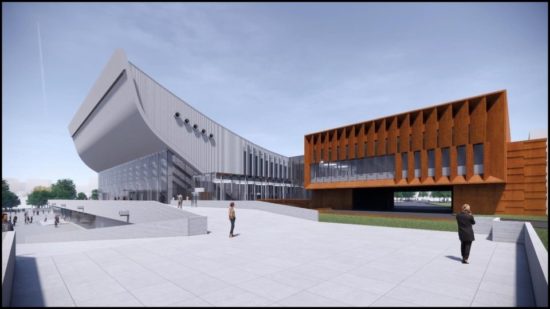◊
The author is chairperson of the Vilnius Committee for Preservation of Piramont (Šnipiškės) Cemetery. A selection of his English articles is available here.
◊

The triumphant new visualization of national convention center and “red annex” in the heart of the Old Vilna Jewish Cemetery, produced at last week’s meeting of Vilnius City Council. Omitted at left: the two “green buildings” constructed on the cemetery in 2005-2008. The earth and bones removed have never been made accessible.
◊
On the 8th of July, Vilnius City Council approved the Joint Activity (Partnership) Agreement Between Vilnius City Municipality Administration and State Enterprise Property Bank. The session is available online. The deliberations on the Jewish cemetery are at timecode 19:50 through to 26:43. The new agreement has been heralded, without mention of ongoing opposition, in triumphant mainstream media reports in Lithuanian and English.
The visualizations published show a brand new Caliornia-redoowd colored annex to be built on to the extant Soviet-era derelict former Sports Palace. This comes as a shock to many, as this past January, Lithuania’s ambassador to Israel, HE Lina Antanavičienė, repeatedly promised a group of top Litvak rabbis, on video, that nothing would ever be built outside the confines of the existing building.
One council member, Ms. Evelina Dobrovolska, a lawyer working with the European Foundation for Human Rights, which is (was?) pursuing the preventive case in the courts against restoration of the Sport Palace in the middle of the Old Vilna Jewish Cemetery at Piramónt (in Šnipiškės), left the meeting for that part of the session, as is the custom for those City Council members whose personal commitments may be seen to be a conflict of interest. But that also meant that there was nobody on hand to effectively offer the Second Opinion (including moral and reputational issues, information on the ongoing court case via a European human rights organization, the international petition, and the scope of opposition).
Continue reading

